
Primula vulgaris, the common primrose, is a species of flowering plant in the family Primulaceae, native to western and southern Europe, northwest Africa, and parts of southwest Asia. The common name is primrose, or occasionally common primrose or English primrose to distinguish it from other Primula species also called primroses. None of these are closely related to the evening primroses.
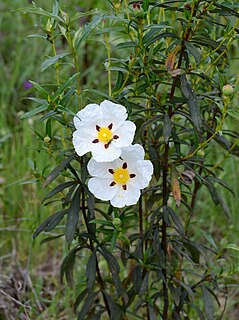
Cistus ladanifer is a species of flowering plant in the family Cistaceae. It is native to the western Mediterranean region. Common names include gum rockrose, labdanum, common gum cistus, and brown-eyed rockrose.
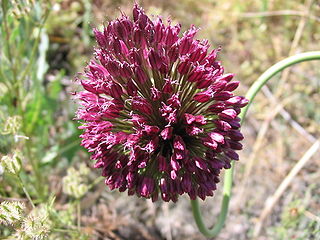
Allium sphaerocephalon is a plant species in the Amaryllis family known as round-headed leek and also round-headed garlic, ball-head onion, and other variations on these names. Other names include Drumsticks, and in Germany, Kugellauch. Some publications use the alternate spelling A. sphaerocephalum. It is a hardy perennial plant.
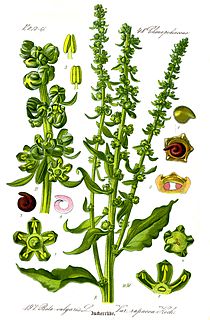
Beta is a genus in the flowering plant family Amaranthaceae. The best known member is the common beet, Beta vulgaris, but several other species are recognised. Almost all have common names containing the word "beet". Wild Beta species can be found throughout the Atlantic coast of Europe, the Mediterranean coastline, the Near East, and parts of Asia including India.
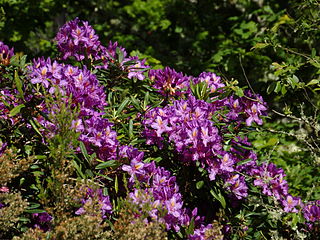
Rhododendron ponticum, called common rhododendron or pontic rhododendron, is a species of Rhododendron native to the Iberian Peninsula in southwest Europe and the Caucasus region in northern West Asia.

The Tiburon paintbrush or Tiburon Indian paintbrush is an endangered taxon of flowering plant in the family Orobanchaceae. It is endemic to the San Francisco Bay Area in California in the United States, where it occurs in Marin, Napa, and Santa Clara Counties.

Simethis is a genus of plants in the family Asphodelaceae, subfamily Hemerocallidoideae. It contains only one known species, Simethis mattiazzii, commonly called the Kerry lily.

Scopula rubiginata, the tawny wave, is a moth of the family Geometridae. The species was first described by Johann Siegfried Hufnagel in 1767.

Digitalis thapsi, which has been called mullein foxglove in the US, is a flowering plant in the genus Digitalis that is endemic to the Iberian Peninsula, where it occurs in eastern Portugal and central and western Spain. It is of commercial importance as an ornamental plant. Hybrids with D. purpurea have proved successful and are fertile.
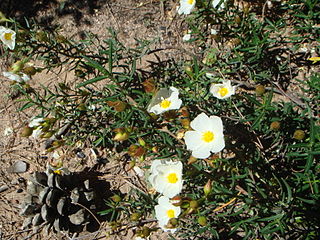
Cistus libanotis is a shrubby species of flowering plant in the family Cistaceae, with white flowers. It has been confused with Cistus clusii, which it resembles, resulting in some uncertainty in its distribution. It is endemic to the Iberian Peninsula.
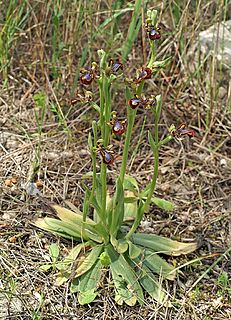
Ophrys speculum, the mirror orchid, is a species of Ophrys distributed throughout the Mediterranean that is pollinated exclusively by a single species of scoliid wasp.

Iris subbiflora is a plant species in the genus Iris, it is also in the subgenus Iris. It is a rhizomatous perennial, from Portugal and Spain in Europe. It has evergreen broad leaves, forming dense clumps, it has dwarf stems in late spring,, with 1 upright fragrant flower, in shades of purple, light red purple, grey-blue, blue-violet, or dark violet. It has a beard which is generally blue, purple, or violet, but can fade to white, dull yellow, or dark yellow. After being found in 1804, it was once a separate species until the late 70s, when it was reclassified as subspecies of Iris lutescens, and renamed Iris lutescens subsp. subbiflora. But in the 80s it was returned to an independent species but some authors and references still class the species as a synonym or subspecies. It is cultivated as an ornamental plant in temperate regions.

Ranunculus bullatus, commonly known as autumn buttercup, is a perennial member of the buttercup family Ranunculaceae, native to Europe and north Africa, including most Mediterranean islands.
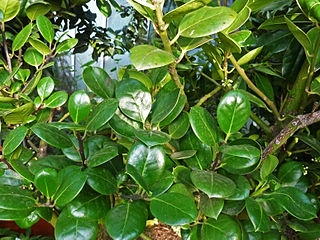
Ilex perado, the Macaronesian holly, is a species of holly endemic to Macaronesia, distributed throughout the Azores, Madeira and Canary islands. It is an important component of the natural high-altitude Macaronesian rainforest, known as 'laurisilva', found mostly at 500 to 1,200 m altitude but it also appears in forest formations at lower altitudes. Many of the subspecies have been classified as threatened, probably because of very small population sizes, and are protected by local, national and regional legislation.

Digitalis mariana is a flowering plant species in the family Plantaginaceae. It is a perennial foxglove with evergreen foliage and rose-red coloured flowers produced in summer. It is native to Portugal and Spain.

Arisarum simorrhinum is species of flowering plant of the family Araceae. It is native to the western Mediterranean Basin.
Herniaria lusitanica is a species of flowering plant in the family Caryophyllales. It is endemic to the Iberian Peninsula and the Berlengas archipelago.
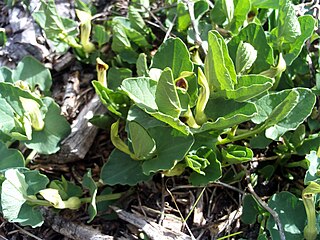
Aristolochia paucinervis is a herbaceous plant in the family Aristolochiaceae endemic to the western Mediterranean Basin.

Orobanche latisquama is a species of broomrape in the family Orobanchaceae native to the western Mediterranean Basin. It is a parasite of rosemary and probably other shrubs.

Aristolochia pistolochia is a herbaceous plant in the family Aristolochiaceae endemic to Mediterranean areas across southwest Europe.
























